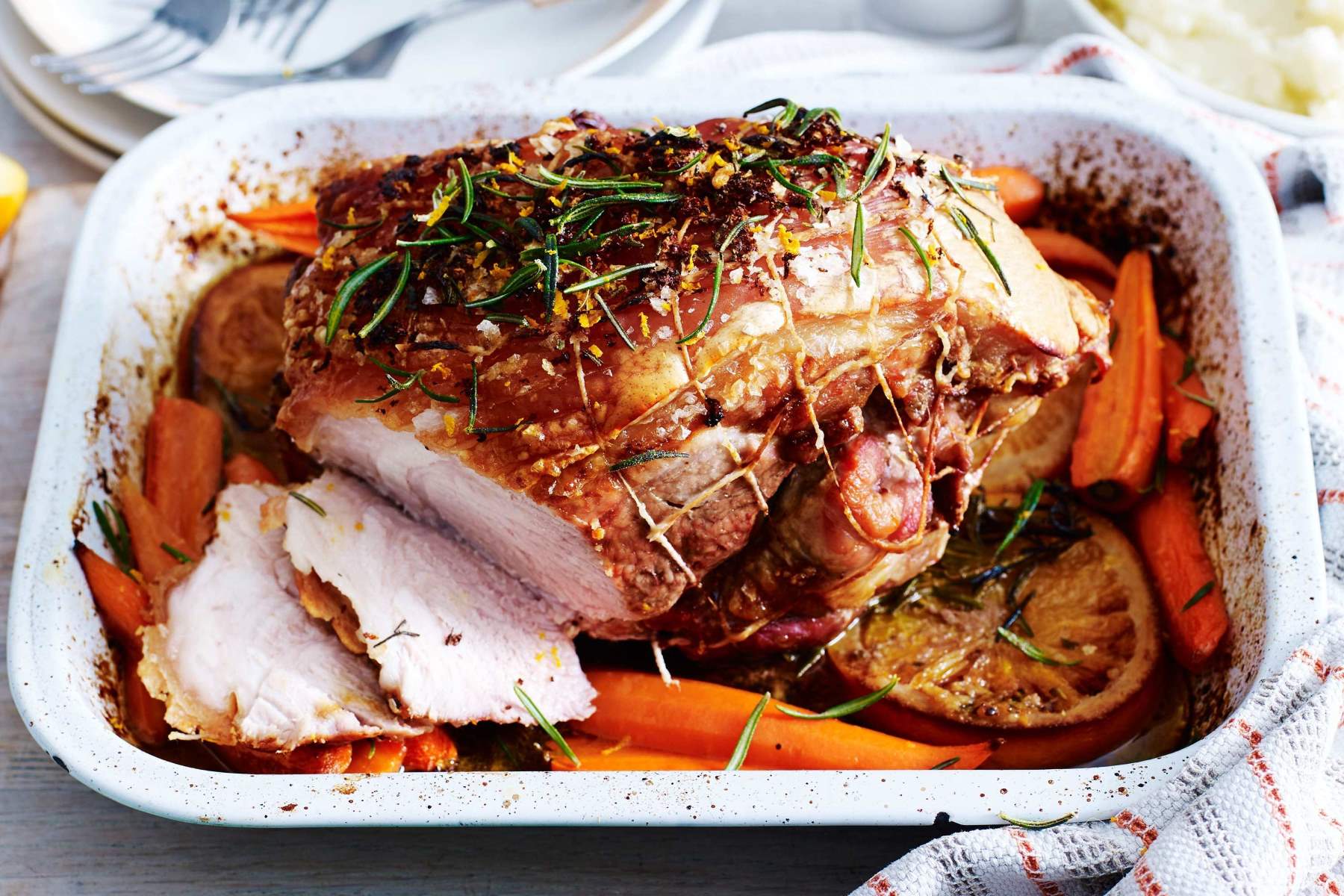A pork roast is a classic dish that brings warmth and comfort to any dining table. With its tender, juicy meat and aromatic herbs, this recipe is perfect for a family gathering or a special occasion. The combination of garlic and rosemary infuses the pork with a delightful flavor, while the olive oil ensures a crispy, golden exterior. Whether you're a seasoned cook or a beginner, this pork roast recipe is simple to follow and promises a delicious result.
When preparing this recipe, you might find that some ingredients are not staples in every pantry. Fresh rosemary is a fragrant herb that adds a unique flavor to the dish, and while it can be found in most supermarkets, it might not be something you have on hand. Additionally, a pork shoulder is a specific cut of meat that may require a visit to the butcher or meat section of your grocery store. Ensure you have these ingredients before starting your culinary adventure.

Ingredients For Pork Roast Recipe
Pork shoulder: A flavorful cut of meat that becomes tender when roasted, perfect for absorbing the herbs and spices.
Olive oil: Used to coat the pork, helping to create a crispy exterior and enhance the flavor.
Salt: Essential for seasoning, bringing out the natural flavors of the pork.
Black pepper: Adds a mild heat and depth of flavor to the dish.
Garlic: Provides a robust, aromatic flavor that complements the pork beautifully.
Rosemary: A fragrant herb that adds a fresh, earthy note to the roast.
Technique Tip for This Dish
To enhance the flavor of your pork roast, consider marinating the pork shoulder overnight. Create a marinade using olive oil, salt, black pepper, minced garlic, and chopped rosemary. Place the pork in a resealable bag with the marinade, ensuring it is well-coated. This allows the seasonings to penetrate the meat, resulting in a more flavorful and tender roast.
Suggested Side Dishes
Alternative Ingredients
pork shoulder - Substitute with beef chuck roast: Beef chuck roast has a similar marbling and texture, making it a good alternative for slow-cooked dishes.
olive oil - Substitute with canola oil: Canola oil has a neutral flavor and similar cooking properties, making it a suitable replacement for olive oil.
salt - Substitute with soy sauce: Soy sauce can add a salty and umami flavor, providing depth to the dish while also seasoning it.
black pepper - Substitute with white pepper: White pepper offers a similar heat and flavor profile, though it is slightly milder and less pungent.
minced garlic - Substitute with garlic powder: Garlic powder can provide a similar flavor, though it is less intense and lacks the texture of fresh garlic.
chopped rosemary - Substitute with thyme: Thyme has a similar earthy and aromatic quality, making it a good alternative to rosemary in savory dishes.
Alternative Recipes Similar to This Dish
How to Store or Freeze This Dish
Allow the pork roast to cool completely at room temperature before storing. This helps prevent condensation, which can lead to sogginess.
For short-term storage, wrap the pork roast tightly in aluminum foil or place it in an airtight container. Store it in the refrigerator, where it will stay fresh for up to 3-4 days.
If you plan to enjoy the pork roast later, freezing is a great option. Slice the roast into manageable portions to make reheating easier and faster.
Wrap each portion in plastic wrap or aluminum foil, ensuring no part of the pork is exposed to air. This helps prevent freezer burn.
Place the wrapped portions in a freezer-safe bag or container. Label with the date to keep track of freshness.
For optimal flavor and texture, consume the frozen pork roast within 2-3 months. While it remains safe to eat beyond this period, the quality may diminish.
When ready to enjoy, thaw the pork roast in the refrigerator overnight. This slow thawing process helps maintain the meat's tenderness and flavor.
Reheat the pork roast in the oven at 325°F (160°C) until warmed through. Cover with foil to prevent drying out, and add a splash of broth or apple juice for added moisture.
Alternatively, use the microwave for a quicker reheating option. Place the pork on a microwave-safe plate, cover with a damp paper towel, and heat in short intervals to avoid overcooking.
Consider using leftover pork roast in creative ways, such as adding it to soups, stews, or sandwiches for a delicious twist.
How to Reheat Leftovers
preheat your oven to 325°f (165°c). wrap the pork roast in aluminum foil to keep it moist. place it on a baking sheet and heat for about 20-25 minutes, or until the internal temperature reaches 140°f (60°c).
slice the pork roast into thin pieces and place them in a skillet with a splash of chicken broth or apple juice. cover and heat over medium-low heat until warmed through, stirring occasionally to ensure even heating.
use a microwave-safe dish and arrange slices of pork roast in a single layer. cover with a microwave-safe lid or plastic wrap, leaving a small vent. heat on medium power for 2-3 minutes, checking and stirring halfway through to ensure even heating.
for a quick fix, use a steamer basket. place the pork roast slices in the basket over simmering water. cover and steam for about 5-7 minutes, or until heated through, ensuring the pork remains juicy.
if you have a sous vide machine, seal the pork roast in a vacuum bag and submerge it in a water bath set to 140°f (60°c). let it warm for about 45 minutes, which will maintain its tenderness and flavor.
Essential Tools for This Recipe
Oven: Used to roast the pork shoulder at a consistent temperature of 350°F (175°C).
Roasting pan: A large pan to hold the pork shoulder while it cooks in the oven, allowing for even heat distribution.
Meat thermometer: Essential for checking the internal temperature of the pork to ensure it reaches 145°F (63°C) for safe consumption.
Knife: Used for slicing the pork after it has rested, ensuring clean and even cuts.
Cutting board: Provides a stable surface for slicing the pork shoulder after it has rested.
Measuring spoons: Used to measure out the olive oil, salt, pepper, and chopped rosemary accurately.
Garlic press: Handy for mincing the garlic cloves efficiently, although a knife can also be used.
Basting brush: Useful for applying the olive oil evenly over the pork shoulder, although hands can also be used for rubbing.
How to Save Time on Preparation
Prepare ingredients in advance: Chop garlic and rosemary the night before to save time on the day of cooking.
Use a meat thermometer: Instead of guessing, use a meat thermometer to check when the pork reaches the perfect temperature.
Preheat the oven early: Start preheating your oven while you prepare the pork shoulder to save time.
Marinate overnight: Rub the pork with olive oil, salt, and pepper the night before for enhanced flavor and efficiency.

Pork Roast Recipe
Ingredients
Main Ingredients
- 4 lb Pork Shoulder
- 2 tablespoon Olive Oil
- 1 teaspoon Salt
- 1 teaspoon Black Pepper
- 4 cloves Garlic minced
- 1 tablespoon Rosemary chopped
Instructions
- Preheat your oven to 350°F (175°C).
- Rub the pork shoulder with olive oil, salt, and pepper.
- Place the pork in a roasting pan and sprinkle with minced garlic and chopped rosemary.
- Roast in the oven for about 2 hours or until the internal temperature reaches 145°F (63°C).
- Let the pork rest for 10 minutes before slicing.
Nutritional Value
Keywords
Suggested Appetizers and Desserts
More Amazing Recipes to Try 🙂
- Ricotta Cheese Recipe40 Minutes
- Pizza Sauce Recipe30 Minutes
- Southern Coleslaw Recipe15 Minutes
- Garlic Sauce Recipe15 Minutes
- Swedish Meatball Sauce Recipe25 Minutes
- Taco Sauce Recipe15 Minutes
- Vodka Sauce Recipe40 Minutes
- Korean BBQ Sauce Recipe20 Minutes


Leave a Reply